ASUS UL80Vt First Look: Mobility Redefined
by Jarred Walton on October 24, 2009 8:00 PM EST- Posted in
- Laptops
ASUS UL80Vt Benchmarked - Battery and LCD
Finally, we have perhaps the most interesting aspect of the UL80Vt. Decent performance and a reasonable size are nice, but there are plenty of laptops to offer those amenities. What truly sets the UL80Vt apart from most other Windows-based laptops is the battery life. ASUS claims "up to 12 hours", and we decided to check their claim.
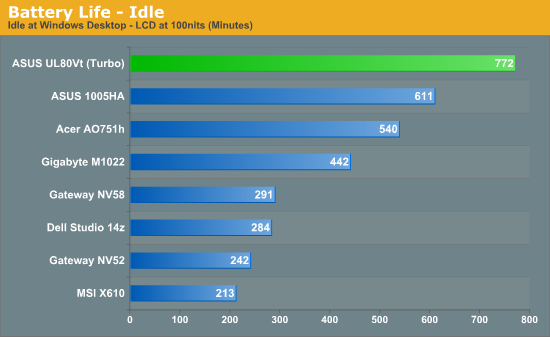
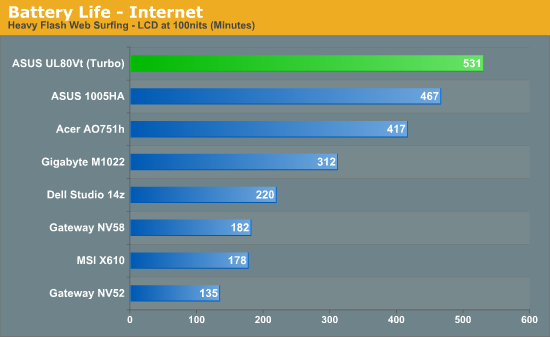
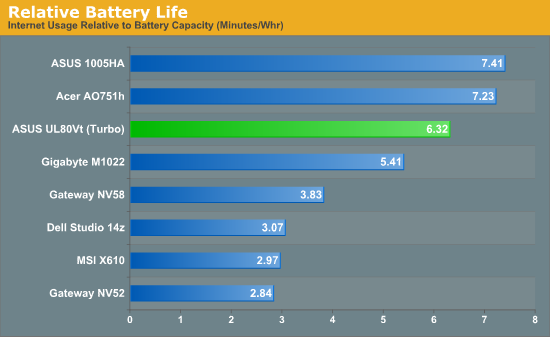
Idle battery life reached nearly 13 hours… and that's what Turbo mode (overclocking) enabled. Granted, the system was sitting idle -- hardly a realistic usage scenario for most users. However, light office use isn't going to be much more taxing than our idle battery life test, and if you decide to disable Turbo mode battery life can only improve. In the far more pertinent Internet battery life, ASUS still achieves record-setting performance. Our initial test (we haven't had time for multiple test runs) came just shy of nine hours of continuous Web surfing. That's with several flash ads on be active website page, which again should be a bit more taxing than what many users view.
Looking at battery capacity and relative battery life, we finally have a true laptop that can actually trade blows with Apple's MacBook line. We never have been able to determine exactly what Apple does in order to achieve their high battery life, but clearly part of it has to be using lower voltage CPUs. ASUS follow suit by using the Core 2 Duo SU7300, which actually surpasses Apple by going with a 10W TDP CPU. Apple currently uses the 25W TDP SP9300, while some previous models used the 17W Core 2 Duo SL9000 series.
Even overclocked the SU7300 practically sips power in comparison to many other CPUs. We measured average power use of 9.5W for the UL80Vt in our internet test compared to 21.1W for the Gateway NV52 and 15.6W for the Gateway NV58. 10.1" and 11.6" netbooks only get down to 8.0-8.5W in the same test, and performance is obviously substantially higher with Core 2 Duo. What's truly impressive is that laptops like the UL80Vt previously sold for nearly $2000 -- sometimes more. With the boom in netbooks sales, manufacturers have apparently realized there's a real market for smaller laptops that get extremely good battery life.
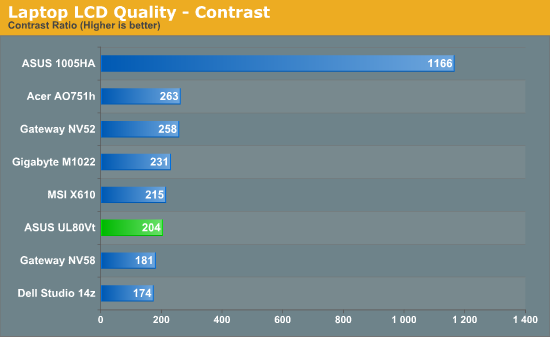
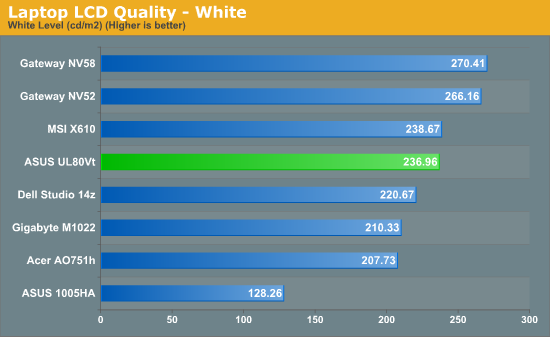
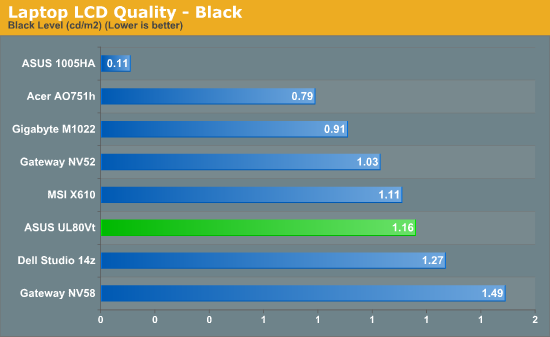
About the only fly in the ointment with the UL80Vt is the LCD panel. Here you can see our contrast ratio test results, and the results are down in the dumps with many other laptops. Sometimes I feel like a lone voice crying in the wilderness telling manufacturers that laptop LCD quality is a serious concern. I know from responses to previous articles that many of you agree, but unfortunately it's something that's difficult to quantify because many reviews don't ever look at LCD quality with quantitative results. ASUS has used very nice LCD panels on lesser offerings (i.e. the Eee 1005HA has an excellent LCD), and we have seen decent displays on other laptops and notebooks as well. If the system cost $25-$50 more but it had a 1000:1 contrast ratio (with an LCD that could still run at 250 nits), I wouldn't hesitate to give the UL80Vt an unequivocal recommendation. As it stands, it's a great laptop but it isn't quite perfect.










100 Comments
View All Comments
ProDigit - Tuesday, October 27, 2009 - link
With the better graphics card I meant the integrated one.. Not the external one.Also, if I'd remove the external graphics card, would I have a PCIE slot available for mods?
ProDigit - Tuesday, October 27, 2009 - link
I don't agree on better LCD's on budget laptops!In fact I oppose it.
I'd rather pay $50 less for a laptop that has a worse LCD, than pay $50 more for a better LCD!
And by the looks of it, we're going that way, with PixelQi's screen which does not display colors faithfully, but could result in upto 20% more batterylife with their white background reflective screens.
I don't care about color precision. A netbook does not need a screen that is showing 32bits faithfully, or that has a high contrast ratio!
What it needs is show basic colors (16 - 24bits is more than ok!), and has a wide range of brightness.
If it isn't reflective (with white background like PixelQi's screens, or e-ink screens), then it needs to have an extreme low setting for comfortably using the PC in a dark room (eg bedroom at night without external light); and the info on the screen should be visible in the daylight, under the sun!
Contrast VS brightness, I'd set my $15 on better brightness settings,rather than pay $50 for a higher quality screen.
Faithful reproduction of screen colors only matter for those who need it, like web designers, photographers, video editors...
But the majority of users are like me. 99% does not care if the green looks a bit blue-ish, or the white looks somewhat a bit yellowish!
strikeback03 - Tuesday, October 27, 2009 - link
But if the screen crushes blacks so badly that all the pics from last Saturdays party that you are looking at on Facebook look like shadows in a coal mine, that screen has failed at even basic functions.Again, I don't think anyone is asking for better screens to be standard, but make them an option in models which are otherwise nice for those who are willing to pay for the upgrade.
atlr - Monday, October 26, 2009 - link
I would pay more for a better display with a matte or antiglare finish.Exile550 - Tuesday, October 27, 2009 - link
I would like very much a matte finish.estyx - Monday, October 26, 2009 - link
Can you please test it when using the GPU for HD-resolution decoding? I.e MPC-HD playing 720p and 1080p h264 with gpu-accel decoding. This is very useful to know when concidering buying a laptop for taking long trips on train, bus, car etc, because then you're so bored you need some movies and series to watch :)Otherwise it seems like a nice laptop! Looking forward for a bit deeper review
JarredWalton - Monday, October 26, 2009 - link
I'm running all sorts of tests as I get the chance. The GMA 4500MHD does x264 offload, as does the G210M. I can tell you that my test x264 720p file just about 6:30 with the 4500MHD; the G210M test is still running. I have a bunch of tests to still run (with and without Turbo, IGP and discrete, gaming performance, etc.) but that will all be revealed eventually. Given the number of tests I still need to run, I expect it to be another week or two before I'm anywhere close to finished.robertpolson - Monday, October 26, 2009 - link
I am dealing with a dilema righ now. Stay with my order for UL80vt, get a macbook pro or wait for UL30vt to come out (if it will) at the end of the year.What I like about UL over macbook pro:
1) Longer battery life
2) More hard drive space
3) Double the memory
What I do not like about UL comparing to macbook pro:
1) No bluetooth
2) Webcam sucks big time - 0.3 megapixel is a joke in 2009
3) Larger in size comapring to macbook pro.
I think I ca live with either OSX and Windows 7.
What do you think ?
JarredWalton - Monday, October 26, 2009 - link
What do you use Bluetooth for? The only time I've ever used it on a laptop was for a Bluetooth mouse, but I'd definitely prefer a wired mouse; the BT mouse was a bit finicky.As for the webcam, I'm not sure if it matters that it's "only" 0.3MP. All the video conferencing stuff I've tried seems to limit me to 320x240 video regardless. I certainly don't take pictures with my laptop webcam; do you?
Mind you, I'm not saying these areas aren't important. You say they are for you, so I'm just wondering what it is you do that I may have overlooked, since I've never felt either was necessary.
PS - Benefit #4: optical drive, if you need it.
heulenwolf - Monday, October 26, 2009 - link
Dear Asus,I've been tracking netbooks since you released the first EEEPC. I always found them interesting but, despite their low price, continued to buy larger laptops or smaller internet-enabled devices until the 1005HAB came out. I saw it while perusing a Best Buy and could not resist. The screen is so nice to look at that it makes me look past some of the drawbacks inherent in a netbook. When at home, I'll gladly use the $300 netbook instead of my $2000 work laptop with a larger screen, faster and better everything (except for the screen, though its no slouch), and longer battery life. When I'm traveling, I don't even consider other options. I bring the 1005HAB. If you'd like this happy Asus EEEPC customer to purchase more lucrative Asus products in the future, please give more weight to the screen quality in your value proposition than was demonstrated in this review.